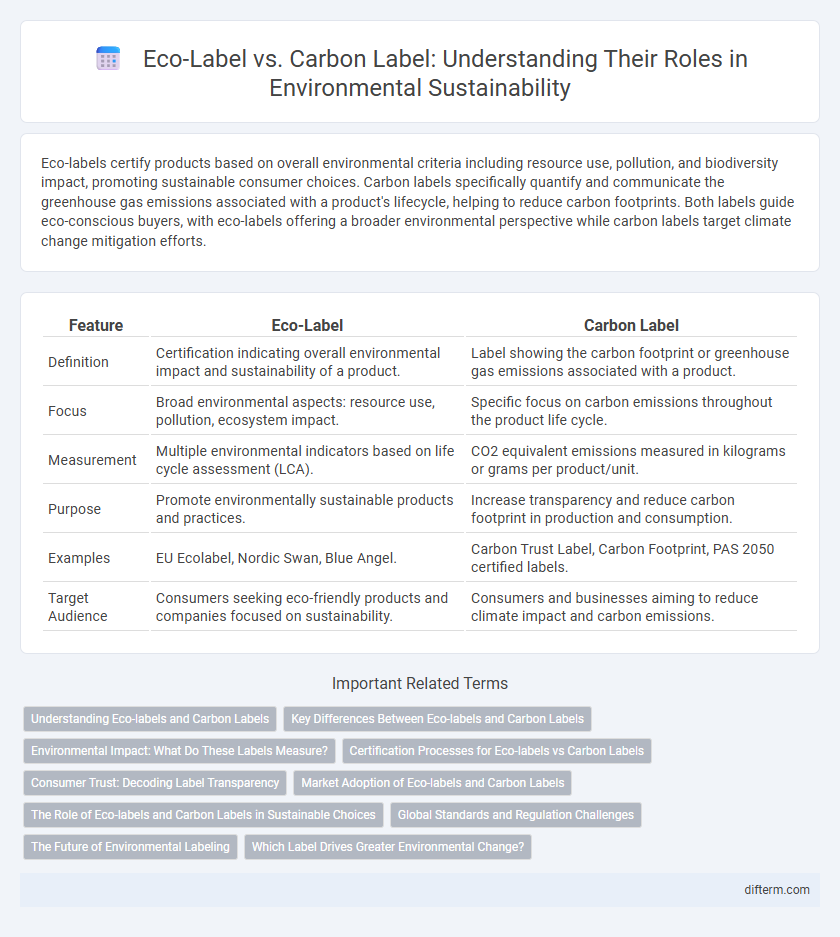Eco-labels certify products based on overall environmental criteria including resource use, pollution, and biodiversity impact, promoting sustainable consumer choices. Carbon labels specifically quantify and communicate the greenhouse gas emissions associated with a product's lifecycle, helping to reduce carbon footprints. Both labels guide eco-conscious buyers, with eco-labels offering a broader environmental perspective while carbon labels target climate change mitigation efforts.
Table of Comparison
| Feature | Eco-Label | Carbon Label |
|---|---|---|
| Definition | Certification indicating overall environmental impact and sustainability of a product. | Label showing the carbon footprint or greenhouse gas emissions associated with a product. |
| Focus | Broad environmental aspects: resource use, pollution, ecosystem impact. | Specific focus on carbon emissions throughout the product life cycle. |
| Measurement | Multiple environmental indicators based on life cycle assessment (LCA). | CO2 equivalent emissions measured in kilograms or grams per product/unit. |
| Purpose | Promote environmentally sustainable products and practices. | Increase transparency and reduce carbon footprint in production and consumption. |
| Examples | EU Ecolabel, Nordic Swan, Blue Angel. | Carbon Trust Label, Carbon Footprint, PAS 2050 certified labels. |
| Target Audience | Consumers seeking eco-friendly products and companies focused on sustainability. | Consumers and businesses aiming to reduce climate impact and carbon emissions. |
Understanding Eco-labels and Carbon Labels
Eco-labels certify products based on comprehensive environmental criteria including resource use, pollution, and social impact, offering consumers a holistic view of sustainability. Carbon labels specifically quantify the greenhouse gas emissions associated with a product's life cycle, providing targeted information on its carbon footprint. Understanding the distinction between eco-labels and carbon labels enables informed decisions that align with broader environmental goals and personal values regarding climate change and sustainability.
Key Differences Between Eco-labels and Carbon Labels
Eco-labels certify products based on overall environmental performance, including factors like resource use, toxicity, and biodiversity impact, while carbon labels specifically quantify the carbon footprint or greenhouse gas emissions associated with a product or service. Eco-labels are often comprehensive, covering various sustainability criteria verified through third-party assessments, whereas carbon labels focus narrowly on CO2 equivalents produced during the lifecycle of a product. The key difference lies in scope--eco-labels address broad environmental impacts, while carbon labels provide targeted information on climate-related emissions to guide eco-conscious consumer choices.
Environmental Impact: What Do These Labels Measure?
Eco-labels measure a product's overall environmental impact, including resource use, pollution, and ecosystem effects throughout its lifecycle. Carbon labels specifically quantify the greenhouse gas emissions generated during production, transportation, and disposal, focusing on carbon footprint reduction. Both labels guide consumers toward sustainable choices by highlighting different aspects of environmental responsibility.
Certification Processes for Eco-labels vs Carbon Labels
Eco-label certification processes involve comprehensive evaluations of a product's environmental impact across its entire lifecycle, including resource extraction, manufacturing, usage, and disposal, often requiring adherence to strict sustainability criteria set by recognized environmental organizations. Carbon label certification specifically measures and verifies the carbon footprint associated with a product or service, focusing primarily on greenhouse gas emissions through a standardized assessment methodology, such as ISO 14067 or the GHG Protocol. Both certifications require third-party verification to ensure accuracy and transparency, but eco-labels tend to cover broader ecological factors, while carbon labels concentrate solely on emissions data.
Consumer Trust: Decoding Label Transparency
Eco-labels provide consumers with verified information about a product's environmental impact, promoting trust through third-party certifications and clear sustainability criteria. Carbon labels focus specifically on the carbon footprint of products, offering transparent data on greenhouse gas emissions associated with production and distribution. Clear and accessible labeling enhances consumer confidence by enabling informed purchasing decisions based on environmental integrity.
Market Adoption of Eco-labels and Carbon Labels
Eco-labels have seen broader market adoption due to established certification frameworks and consumer trust in environmental claims, with over 460 ecolabels recognized globally, influencing purchasing decisions in sectors like food, textiles, and electronics. In contrast, carbon labels, which quantify the carbon footprint of products, are gradually gaining traction, supported by initiatives like the Carbon Trust Standard and emerging regulatory pressures aimed at reducing greenhouse gas emissions. Market adoption trends indicate eco-labels currently dominate mainstream consumer markets, while carbon labels are positioned for growth driven by increasing awareness of climate change and corporate sustainability commitments.
The Role of Eco-labels and Carbon Labels in Sustainable Choices
Eco-labels certify products based on comprehensive environmental criteria, guiding consumers toward sustainable choices by highlighting eco-friendly production and resource use. Carbon labels specifically quantify the carbon footprint of products, enabling consumers to assess and reduce greenhouse gas emissions in their purchasing decisions. Together, eco-labels and carbon labels empower informed, environmentally responsible consumption that supports global sustainability goals.
Global Standards and Regulation Challenges
Eco-labels are globally recognized certifications that verify a product's environmental performance based on comprehensive criteria such as resource efficiency, pollution reduction, and sustainable sourcing, often governed by international standards like ISO 14024. In contrast, carbon labels specifically quantify and disclose a product's carbon footprint, reflecting greenhouse gas emissions throughout its lifecycle, but currently lack universally harmonized regulations, leading to variability in methodology and reporting. The main regulatory challenge lies in aligning diverse national policies and measurement frameworks to establish consistent, transparent, and comparable labeling standards across global markets.
The Future of Environmental Labeling
Eco-labels and carbon labels are evolving to provide clearer, more actionable information for consumers aiming to reduce environmental impact and carbon footprints. Emerging technologies and standardized metrics enhance transparency and credibility, driving widespread adoption across industries. Future environmental labeling will integrate real-time data and lifecycle analysis, empowering informed decisions aligned with global sustainability goals.
Which Label Drives Greater Environmental Change?
Eco-labels emphasize comprehensive environmental standards across product lifecycles, promoting sustainable sourcing, reduced pollution, and biodiversity conservation, thereby driving broader systemic change. Carbon labels specifically quantify greenhouse gas emissions, targeting carbon footprint reduction and raising consumer awareness about climate impact. While carbon labels focus on climate-driven purchasing decisions, eco-labels foster holistic environmental improvements by encouraging sustainable production and consumption practices.
Eco-label vs Carbon label Infographic

 difterm.com
difterm.com